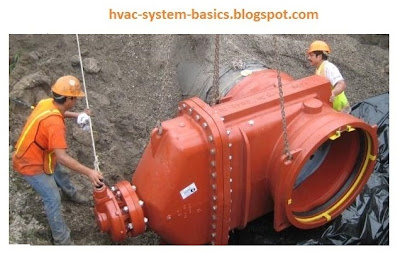Definition of Valve
- In mechanical engineering, a Valve is a mechanical device that controls the flow of fluid and pressure within a system or process.
---------------------------------------------------------------------------------------------
- Valve is any device for closing or modifying the passage through a pipe, outlet, inlet, or the like, in order to stop, allow, or control the flow of a fluid media.
---------------------------------------------------------------------------------------------
- Valve is mechanical or electromechanical device by which the flow of a gas, liquid, slurry, or loose dry material can be started stopped, diverted, and/or regulated or throttled.
Use of Valve or Applications of
valves
Valve is found everywhere. Applications of valves have
great variety and breath. Where there is flow of fluid, there would be valve
to control the flow.
Can you think of pipe having fluid (liquid or gas) running
through it and no valve to stop, start or regulate the flow?
Valves are found
in power plants, process plants, hydal applications, hvac application and
domestic applications. Valve is used in steam lines and gas lines also for
control purposes. Air control valve is also use for control purposes .Failures of valves may be catastrophic for the whole system
depending upon the type of application.
Leaky, rusty and noisy valves indicate
the lack of right Maintenance Programs for valves. Sometimes valve leaks may
have health hazards .Obviously no one wants to waste chemistry controlled fluid
through these valves. Your leaky valve would make it impossible to isolate any
equipment or system at the time of maintenance so all valves need attention
before they become headache for you.
Function of valve
A valve controls system or process fluid flow and pressure.
These aforesaid objectives of valves are achieved by performing any of the
following functions:
- Stopping and starting flow of fluid
- Varying (throttling) the amount of flow of fluid
- Regulating downstream system or process pressure
- Controlling the direction of flow of fluid
- Relieving component or piping over pressure
Flow
control Valve ------- 4 Methods By which it works
As a student of
mechanical engineering, plant engineers, plant technician, maintenance
technician or plant operator you might be interested in knowing how flow is
controlled in these valves. In general, there are four methods of controlling
flow through a valve.
- Move a disc, or plug into or against an orifice (for example, globe or needle type valve).
- Slide a flat, cylindrical, or spherical surface across an orifice (for example, gate and plug valves).
- Rotate a disc or ellipse about a shaft extending across the diameter of an orifice (for example, a butterfly or ball valve).
- Move a flexible material into the flow passage (for example, diaphragm and pinch valves).
